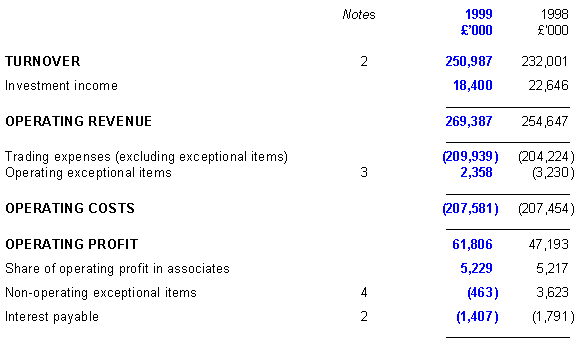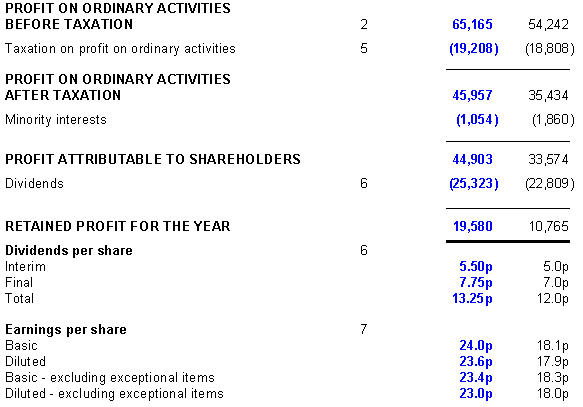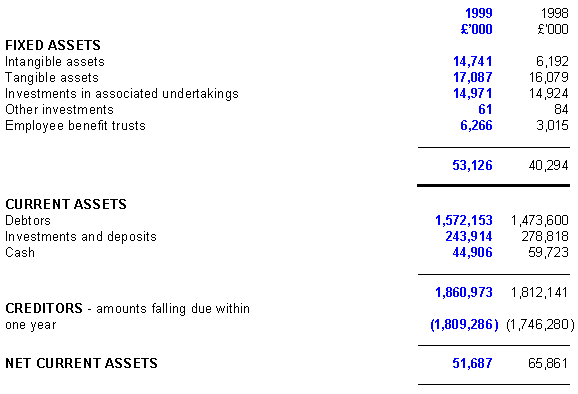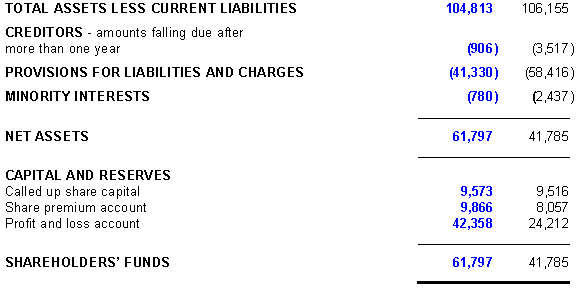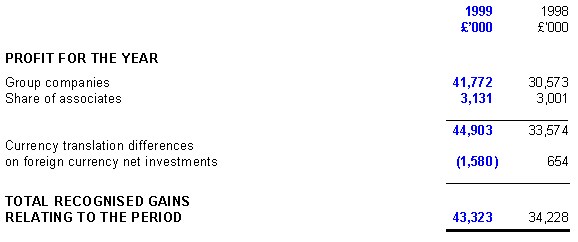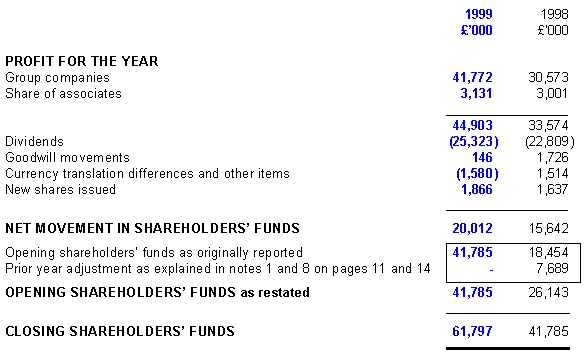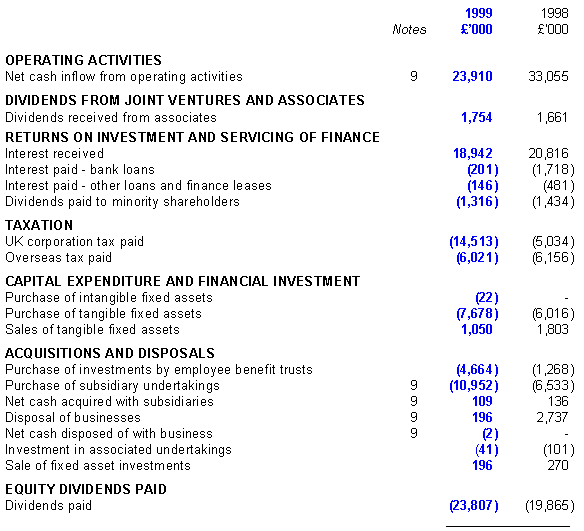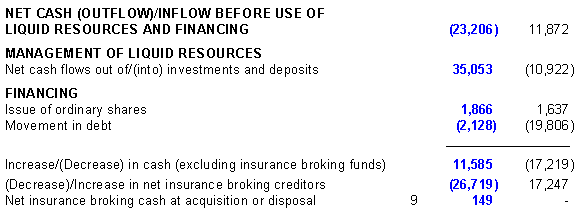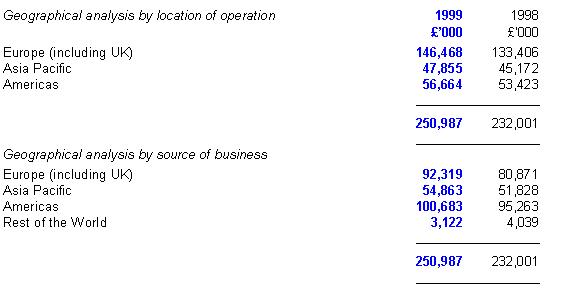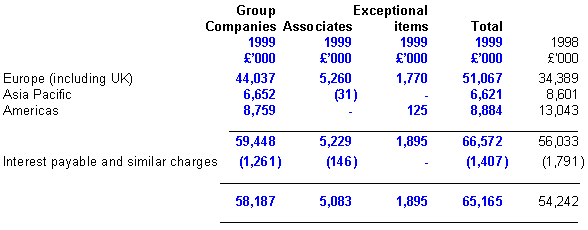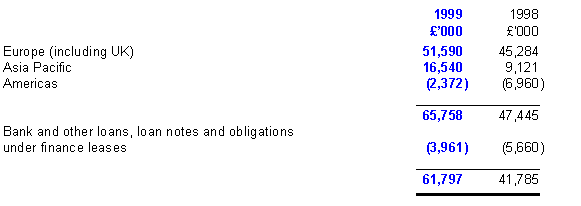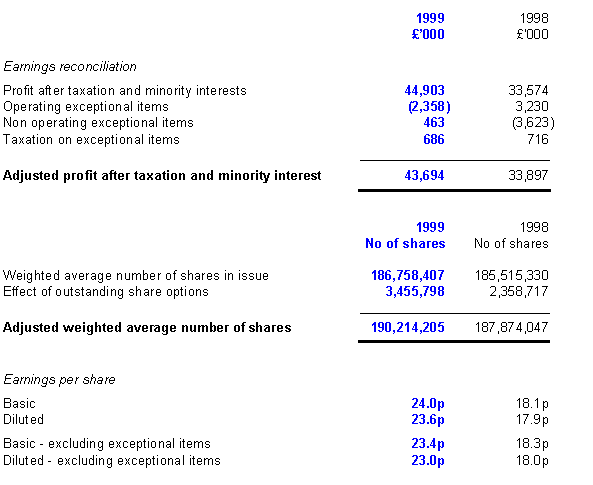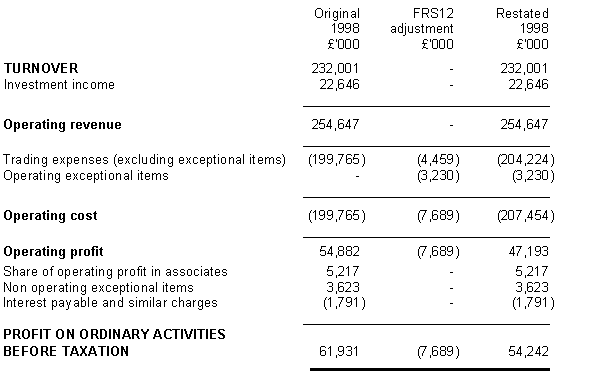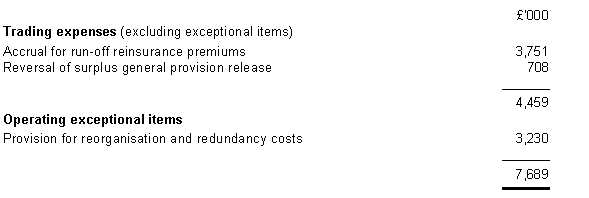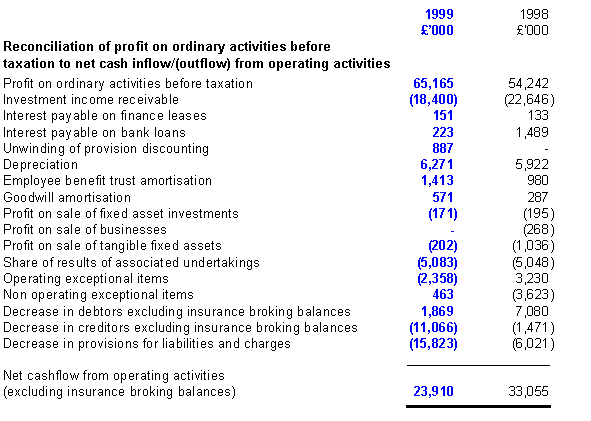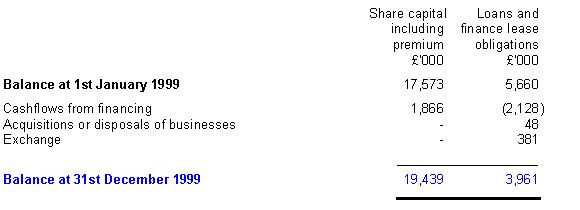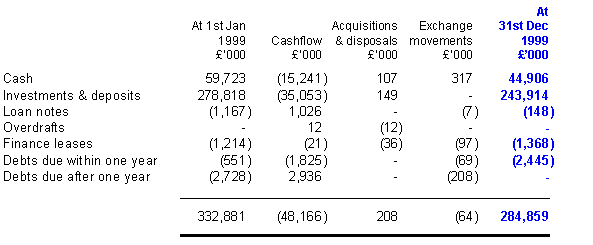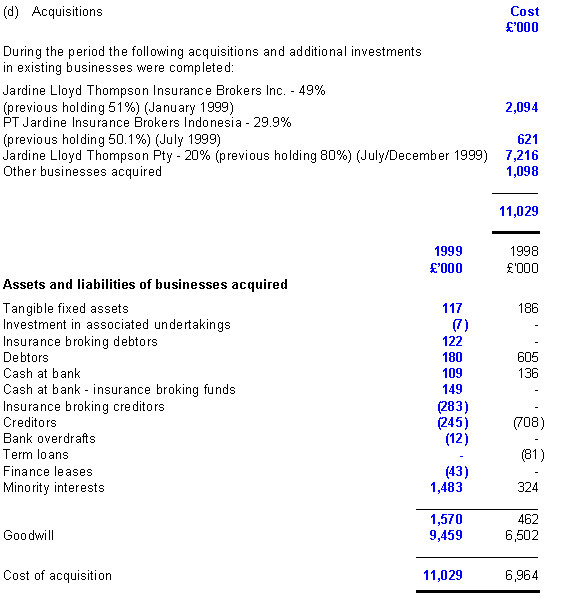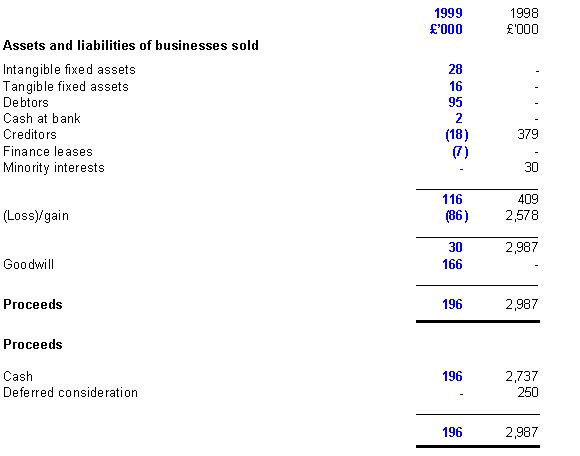
24th February 2000
JARDINE LLOYD THOMPSON GROUP plc The following press release was issued today by the Company's 33%-owned associate, Jardine Lloyd Thompson Group plc.
For further information please contact:
Full text of this and other Group announcements can be accessed through the Internet at "http://www.irasia.com/listco/sg/jml". Group plc 24th February 2000 JARDINE LLOYD THOMPSON GROUP plc PRELIMINARY RESULTS FOR THE YEAR ENDED 31st December 1999 Jardine Lloyd Thompson Group plc today announces the preliminary results of the Group for the year ended 31st December 1999. Profit before tax and exceptional items was £63.3 million for the year ended 31st December 1999 (1998: £58.3 million). The Group has declared a final dividend of 7.75p (net) per share, making a total of 13.25p for the year (1998: 12.0p). The final dividend will be paid, subject to shareholder approval, on 15th May 2000. Highlights:
Note: All comparatives are stated prior to restatement to comply with FRS12 as explained in Notes 1 and 8. Ken Carter, Chief Executive, commented: "These strong results have been achieved purely through organic growth and demonstrate the success of our new strategy and operating plan adopted at the start of 1999. We are encouraged by the positive response throughout the Group as we made these changes and it is a credit to our colleagues that the growth in 1999 was achieved during this period of change."
PRELIMINARY STATEMENT JLT's impressive performance during the first half of the year continued in the second half with profit before tax and exceptional items for the year increasing by 9% to £63.3 million (1998: £58.3 million). Insurance market conditions continued to be challenging, with growth in profits contained by low interest rates and the continuing strength of sterling. Competition has remained intense and it is a great tribute to the Group that we have been able to increase the rate of revenue growth in the second half of the year to 10%. Revenue for the year was £251 million, an increase of 8% over 1998 on a comparable basis. The Group's continued focus on managing costs has improved our trading profit - defined as turnover less expenses - by 27%, more than offsetting the fall in interest earnings. At the beginning of 1999 the Group was reorganised into three core business areas: Risk Solutions; Corporate Risks and Services. This has proved to be an effective and efficient method of managing the Group as each of these business areas has faced differing conditions and challenges during the year. In Risk Solutions, outstanding growth in new forms of business - including the further development of alternative risk transfer ("ART") products - was underpinned by a strong performance in its core insurance broking activities and overall revenues increased by 12%. Risk Solutions has gained important new clients in almost every area of its business in the last year. Its ability to win new business and increase revenues and profitability highlights the value that clients attribute to Risk Solutions' services. Corporate Risks & Services enjoyed a satisfactory performance in several of its business areas. Overall, this business group achieved revenue growth of 5% and much planning has been done that will bring benefits in the future. During 1999 we established a new centre in Singapore with the twin objectives of managing and supporting our Corporate Risks businesses in Asia and building synergy with the rest of the Group. We also acquired the outstanding minority interests in our companies in Australia and the Philippines and made further investment in Indonesia in order to enable us to benefit fully from the greater opportunities afforded by the new operating structure. Our balance sheet has continued to strengthen and our sound financial position gives us great flexibility and provides a solid platform for future growth. Although our industry has gone through relatively little structural change during the year, we can anticipate renewed change in the future. In the U.S. the passing of the Financial Services/Modernization Act opens up the prospect of alliances between the banking and insurance sectors which may take the consolidation we have seen in our markets to new levels. Our position as the only significant quoted UK broker is proving to be a positive advantage. We have continued to win significant new business while retaining and expanding relationships with existing customers. This trend has continued into 2000 with a very high level of activity in all of our operations and new opportunities arising to win business and employ highly talented staff. Dividends A final dividend of 7.75p (net) per share for the year to 31st December 1999 will be paid, subject to shareholder approval, on 15th May 2000 to shareholders on the register on 14th April 2000. This gives a total dividend for the year of 13.25p (net) per share and compares with 12p (net) for 1998. Exceptional Items As well as requiring the restatement of the comparative profit and loss figures for 1998, the adoption of FRS 12 has also necessitated a revision of the amounts previously recognised as provisions for future rental costs in respect of surplus properties and deferred consideration in order to reflect the time value of money. The discounting of such provisions resulted in an operating exceptional credit of £4.1 million, offset in part by the creation of an additional provision for future rental costs of £1.7 million. The sale and costs associated with the closure of certain small, non-core businesses resulted in net non-operating exceptional costs of approximately £0.5 million. Comparative Figures for 1998 The figures for 1998 have been restated to comply with FRS12, see notes 1 and 8. Operational Review Group Strategy These results have been achieved purely through organic growth and demonstrate the success of our new strategy and operating plan adopted at the start of 1999. In essence, the Group's strategy is to focus on three core businesses: Risk Solutions, serving clients who require professional advice and an innovative transactional service; Corporate Risks, serving clients who require a full risk management service; and Services, whose clients wish to outsource affinity group marketing, employee benefits, claims and insurance fund administration. Considerable effort and energy has been directed at implementing the new operating structure that flowed from this strategy. We are encouraged by the positive response throughout the Group as we made the fundamental change of moving from a geographic to a functional structure. It is a further credit to our colleagues that growth reflected in the results for 1999 was achieved at a time of such considerable organisational change. Risk Solutions The Risk Solutions business group consists of JLT Risk Solutions Ltd., which comprises our very substantial London based insurance, reinsurance and alternative risk transfer businesses, together with our reinsurance business in America, our captive management and specialty broking businesses in London, Bermuda and Sweden and those overseas representative offices whose business is handled in the London market. Risk Solutions was created in March 1999 in the belief that all clients will expect product innovation and standards of service of the highest levels. Risk Solutions is designed to meet and exceed these expectations in every aspect of its business. By building on its traditional strengths and taking advantage of the changing dynamics of global financial and insurance markets, Risk Solutions can provide clients with products and services that address risk in its widest sense. ART combines risk consultancy with execution and is fast developing as a form of business that bridges financial and insurance solutions and markets. By applying financial market techniques to conventional insurance products, clients can benefit from the best aspects of both. In 1999 Risk Solutions increased its revenues by 12% from £104 million to £117 million. The improvement came right across the company. Energy, marine, cargo and construction business units all won significant new clients and there were excellent results from casualty, property and reinsurance. Financial risks and special risks together grew their business by more than 50%. Whilst conventional insurance products remain its core business, Risk Solutions' ability to transcend traditional boundaries of insurance by offering ART and related products affords the prospect of quality growth in earnings in the future. Annual revenue from this source is now some £16 million and grew by 60% during 1999. Elsewhere in this business group Jardine Sayer, our American reinsurance business, again achieved excellent growth, as did Triangle, the Bermuda-based captive management and specialty broking business and Agnew Higgins Pickering & Company, our London based energy specialist. Financial Solutions in Bermuda and Sweden maintained revenue for the year. In 1999, Risk Solutions improved its profitability and achieved a trading margin of 27%. Corporate Risks & Services This business group is responsible for two core businesses. Included within Corporate Risks are our offices in the UK, Ireland, Canada, Australia and Brazil, all of which achieved satisfactory brokerage growth. Also included in Corporate Risks is our business in Asia, which suffered the delayed impact of the economic problems that surfaced in 1997. Overall, Corporate Risks brokerage grew marginally by 2% from £68.5 million to £70.1 million. Our associate in France, SIACI, which also operates within this business group, enjoyed another successful year. In Services, our Affinity Group Marketing businesses in America achieved growth, while the UK business maintained its position. In Employee Benefits, our UK business achieved double digit revenue growth, while Claims and Insurance Fund administration in Australasia, Canada and the UK achieved significant growth. Overall, Services income grew by 8% from £59.5 million to £64.1 million - a creditable performance in the circumstances. Two businesses in America with combined brokerage of £5.3 million were sold in January 2000 in line with the programme started in 1998 of disposing of businesses in which we were unlikely to become market leaders or achieve a meaningful industry position. Within Corporate Risks & Services much work was done last year to establish the unified approach that these businesses need in order to succeed in the future. Our aim is to create, through a combination of organic growth and selective acquisitions, core businesses with the appropriate critical mass. Our e-commerce strategy is to generate further growth by investing in two distinct areas. An internal unit is focusing on e-commerce applications for affinity groups and e-business applications for process efficiency. In parallel with this, we are seeking alliances with pure web businesses which need traditional support functions. We expect our investment in these areas to be in the region of £10 million over the next three years. In 1999, Corporate Risks & Services achieved a trading margin of just over 10%. Insurance Markets For most of 1999 insurance markets continued to be very soft. Towards the end of the year parts of the reinsurance market began to harden and by the end of the year this change began to affect some areas of the direct market. In London, rates are hardening in certain lines but conditions differ from market to market. Rates are hardening in Australia but not in Asia and have started to rise in the French market where this trend is likely to be reinforced following the storms at Christmas. Board John Lloyd is retiring from the Board with effect from 29th February 2000 although he continues as Executive Chairman of JLT Risk Solutions. David Corben, Dennis Guy and Jonathan Marland will also retire from the Board on the same date; we are pleased to report that each will continue to serve the Group in a consultancy role, focusing on maintaining and developing key client relationships. The Board is indebted to each of these directors for their significant contribution and support to the success of the Group through an exciting and challenging period in its development. We look forward to their ongoing association with the Group in the years ahead. Prospects The year 2000 will see continuing change in our markets worldwide. Although there are clear signs that insurance rates are rising in certain sections of the market it is too early to predict the effect on our business. However, we are confident that our existing strong client base will provide a solid platform for continued growth which will be enhanced by the expansion of our ART business. Additionally, our developing e-commerce strategy is expected to form an important part of the Group's future development. We continue to believe that our unique position in the market will enable us to thrive and produce continued growth in both revenues and profitability for our shareholders.
John Barton 24th February 2000 Consolidated Profit and Loss Account For the year ended 31st December 1999
Consolidated Balance Sheet As at 31st December 1999
Statement of Total Recognised Gains and Losses For the year ended 31st December 1999
Reconciliation of Movement in Shareholders' Funds For the year ended 31st December 1999
Consolidated Cashflow Statement For the year ended 31st December 1999
Notes to the Preliminary Results For the year ended 31st December 1999 1 Basis of Accounting The Group financial statements have been prepared on the going concern basis under the historical cost convention and in accordance with applicable accounting standards. In accordance with the requirements of Financial Reporting Standard 12 (FRS 12) (Provisions, Contingent Liabilities and Contingent Assets) the Group has discounted certain provisions to their present value. The profit and loss account impact of the provision discounting has been treated as an operating exceptional item in the year to 31st December 1999. Certain general provisions which previously existed but are no longer permitted under FRS12 have been eliminated as prior year adjustments to the shareholders' funds at 31st December 1997. The comparative profit and loss account for 1998 has been restated to reflect the creation of specific provisions and accruals together with the elimination of the release of surplus general provisions previously accounted for in 1998. FRS12 has also required the re-classification of £25,913,000 of current liabilities to provisions for liabilities and charges in the balance sheet at 31st December 1998. The shareholders' funds at that date remain unchanged. Where appropriate, comparative information for 1998 has been restated and note 8 on page 14 shows the effect of the restatement on the comparative profit and loss account for 1998. 2 Segmental Information Turnover
Profit on ordinary activities before taxation
Interest payable and similar charges includes £887,000 (1998: Nil) in respect of the unwinding of provision discounting. Net operating assets and liabilities
3 Operating Exceptional Items
4 Non Operating Exceptional Items
5 Taxation The charge to taxation for the year to 31st December 1999, includes taxation of £5,805,000 (1998: £6,247,000) in respect of overseas subsidiary profits and £1,923,000 (1998: £2,028,000) in respect of associated company profits. 6 Dividends
The final dividend is payable on 15th May 2000 to shareholders who are registered at the close of business on 14th April 2000. The ex-dividend date will be 10th April 2000. 7 Earnings per Share i) Basic earnings per share are calculated by dividing the profit after taxation and minority interests by the weighted average number of shares in issue. ii) Diluted earnings per share are calculated by dividing the profit after taxation and minority interests by the adjusted weighted average number of shares in issue. iii) Basic earnings per share, excluding exceptional items, are calculated by dividing the adjusted profit after taxation and minority interests by the weighted average number of shares in issue. iv) Diluted earnings per share, excluding exceptional items, are calculated by dividing the adjusted profit after taxation and minority interests by the adjusted weighted average number of shares in issue. The weighted average number of shares in issue has been calculated after excluding the Group's share of SIACI's interest in the share capital of Jardine Lloyd Thompson Group plc together with the shares held by the Trustees of the Employees' Share Ownership Plan Trust in respect of the Jardine Lloyd Thompson Group Restricted Share Scheme. Following the introduction of FRS 12, the comparative figures for the year ended 31st December 1998 have been restated in line with the restated profit and loss account as explained in notes 1 and 8 on pages 11 and 14.
8 Comparative Restatement As explained in Note 1, the introduction of FRS12 has required that the comparative Profit and Loss Account for 1998 be restated. Detailed below is the effect of this restatement.
The restatement of the 1998 profit & loss account reflected the following:
9 Notes to the Consolidated Cashflow Statement (a) Net cash inflow from operating activities
(b) Analysis of changes in financing during period
(c) Analysis of net funds
All assets and liabilities are stated at their fair value, no adjustment has been made to their book value. (e) Disposals During the year the company sold a number of small businesses, none of which was individually significant
All assets and liabilities are stated at their fair value. No adjustment has been made to their book value. 10 Year 2000 Although it is recognised that the impact on IT systems of Y2K may be felt not only on 1st January but also during the succeeding months, the date change itself passed uneventfully with no adverse consequences for the Group. 11 The financial information contained in this preliminary announcement does not constitute statutory accounts within the meaning of Section 240 of the Companies Act 1985. The results for the year ended 31st December 1999 are unaudited and statutory accounts have not yet been delivered to the Registrar of Companies. 12 Statutory accounts for the year ended 31st December 1999 will be posted to shareholders no later than 20th March 2000 and delivered to the Registrar of Companies following the Annual General Meeting on 5th May 2000. 13 The shareholders entered in the Register of Members at 4.00pm on 14th April 2000 will be entitled to the proposed final dividend of 7.75p per share which will, subject to approval at the Annual General Meeting to be held on 5th May 2000, be payable on 15th May 2000. 14 Copies of the preliminary press release (and statutory accounts when available) may be obtained from the Secretary, Jardine Lloyd Thompson Group plc, 6 Crutched Friars, London EC3N 2PH.
|
 |
